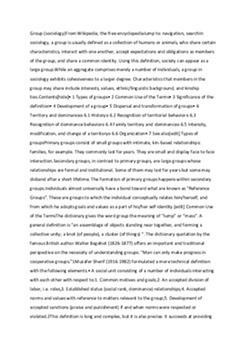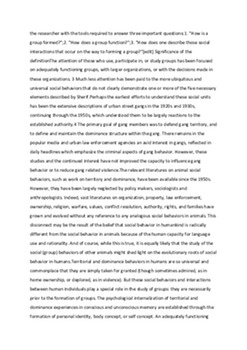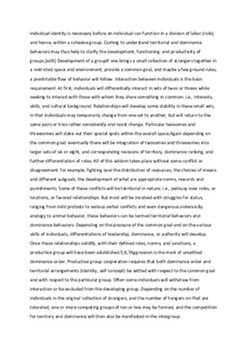Sociālās grupas



Group (sociology) From Wikipedia, the free encyclopedia Jump to: navigation, search In sociology, a group is usually defined as a collection of humans or animals, who share certain characteristics, interact with one another, accept expectations and obligations as members of the group, and share a common identity. Using this definition, society can appear as a large group. While an aggregate comprises merely a number of individuals, a group in sociology exhibits cohesiveness to a larger degree. Characteristics that members in the group may share include interests, values, ethnic/linguistic background, and kinship ties. Contents [hide] • 1 Types of groups • 2 Common Use of the Terms • 3 Significance of the definition • 4 Development of a group • 5 Dispersal and transformation of groups • 6 Territory and dominance o 6.1 History o 6.2 Recognition of territorial behavior o 6.3 Recognition of dominance behavior o 6.4 Family territory and dominance o 6.5 Intensity, modification, and change of a territory o 6.6 Organization • 7 See also [edit] Types of groups Primary groups consist of small groups with intimate, kin-based relationships: families, for example. They commonly last for years. They are small and display face to face interaction. Secondary groups, in contrast to primary groups, are large groups whose relationships are formal and institutional. Some of them may last for years but some may disband after a short lifetime. The formation of primary groups happens within secondary groups. Individuals almost universally have a bond toward what are known as "Reference Groups". These are groups to which the individual conceptually relates him/herself, and from which he adopts goals and values as a part of his/her self identity. [edit] Common Use of the Terms The dictionary gives the word group the meaning of “lump” or “mass”. A general definition is “an assemblage of objects standing near together, and forming a collective unity; a knot (of people), a cluster (of things) ”. The dictionary quotation by the famous British author Walter Bagehot (1826-1877) offers an important and traditional perspective on the necessity of understanding groups: “Man can only make progress in cooperative groups.”1 Muzafer Sherif (1916-1982) formulated a more technical definition with the following elements: • A social unit consisting of a number of individuals interacting with each other with respect to: 1. Common motives and goals; 2. An accepted division of labor, i.e. roles, 3. Established status (social rank, dominance) relationships; 4....
- Microsoft Word 17 KB
- Latviešu
- 10 lapas (4077 vārdi)
- Universitāte
- Saniitis
-









